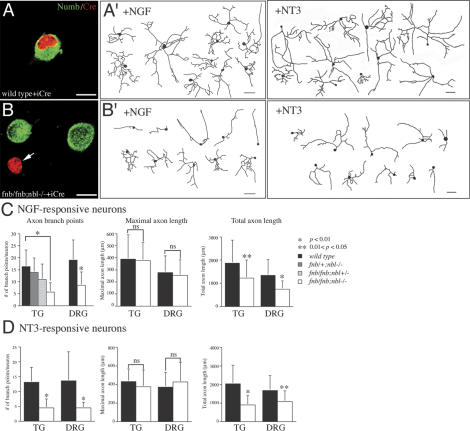Figure 4.
Loss of Numb and Nbl results in reduced axonal length and arborization in sensory neurons in culture. (A) Expression of Cre recombinase in control sensory neurons did not affect the level of endogenous Numb protein. (B) In contrast, Cre recombinase effectively abolished the expression of Numb in fnb/fnb;nbl–/– neurons (arrow), whereas the level of endogenous Numb protein remained unchanged in neurons without Cre. (A′,B′) Camera lucida drawings of axons in control neurons grown in the presence of NGF or NT3 (A′) and fnb/fnb;nbl–/– (B′) neurons upon expression of Cre recombinase. Bars: A–B, 10 μm. (C) For NGF-responsive neuron, cultured from either trigeminal ganglion (TG) or dorsal root ganglia (DRG), loss of Numb and Nbl reduced axon branch points and total axon length, without affecting the maximal axon length. Compared with wild-type neurons, the number of axon branch points and branch index were significantly reduced in fnb/fnb;nbl–/– neurons, but not in fnb/+;nbl–/– or fnb/fnb;nbl+/– neurons. *p < 0.01; **0.01 < p < 0.05. The maximal axon length, however, was not significantly different between wild-type and fnb/fnb; nbl–/– neurons. (D) Loss of Numb and Nbl also had similar effects on the axon branch points and total axon length in NT3-responsive neurons from both TG and DRG. *p < 0.01; *0.01 < p < 0.05. Paired Student's t-test was performed for each statistical analyses, except the axon branch point panel of C, where one way ANOVA was used followed by a Tukey multiple comparison test.

